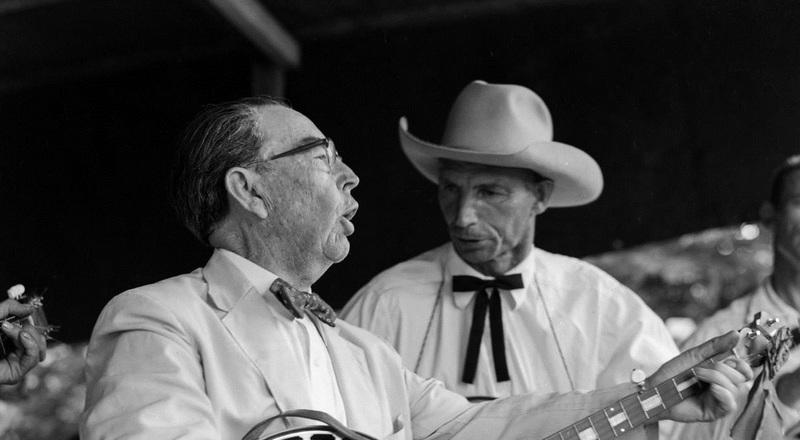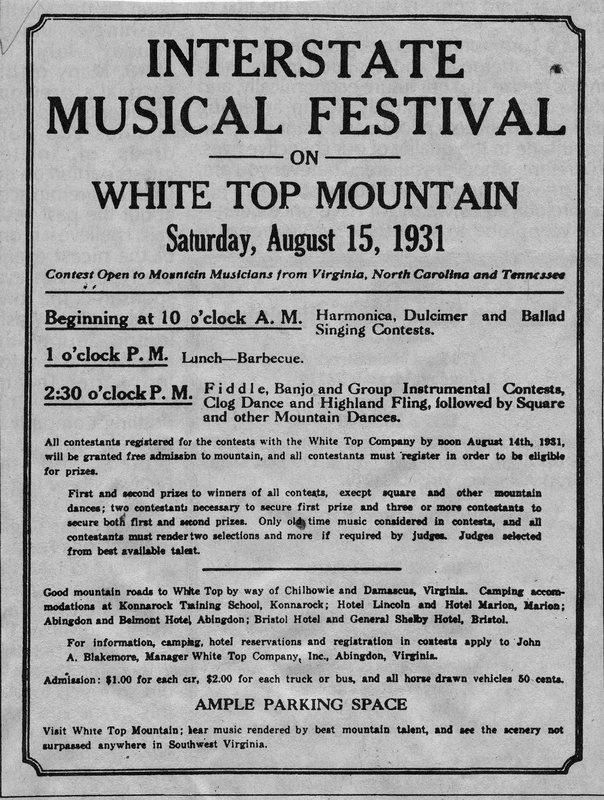1931 Festival
The progenitor of the White Top Folk Festival was the first Virginia Choral Festival in Charlottesville, VA in 1928 which was organized by Annabel Morris Buchanan and John Powell and which also included folk music. A number of notable performers from Southwest Virginia appeared there including Horton Barker, Jack Reedy, C.B. Wohlford and Ed and Frank Blevins. These artists formed the core of performers who appeared at White Top throughout the 30’s.The festival organizers were influenced by the mountain settlement schools which sought not only to educate Appalachian children, but also to discover and preserve mountain culture.
The first festival included competitions in which eight fiddlers, six banjo and guitar players, seven clog dancers, six string bands, four ballad singers, two harmonica players, and one or two dulcimer players took part. Judges for the performances were Lamar Stringfield, John Powell, Annabel Morris Buchanan, George Pullen Jackson, who was an expert on white spirituals from Vanderbilt University, and Arthur Knecht who was the director of the Cincinnati Symphony.

Beginning in 1927 as the Rhododendron Festival, Bascom Lamar Lunsford's Asheville Mountain Dance and Folk Festival was a predecesor to the White Top Festival.
By 1931 when the first White Top Folk Festival took place there already were two similar festivals in existence. In 1928, Bascom Lamar Lunsford had organized a group of performers in Asheville, NC to perform traditional music and dance in what would become known as the Mountain Dance and Folk Festival. Inspired by Lunsford’s success in North Carolina, Jean Thomas formed the American Folk Song Festival to promote mountain music in Kentucky. The National Folk Festival, begun by Sarah Gertrude Knott in 1934, was held at various locations and, as the name suggests, focused on folk music as it found expression in different parts of the country.
[Encyclopedia of Appalachia, p. 861]

Council Cruise was from nearby Damascus, Va. He and his family were fixtures at the WTFF. "Each year he performed and brought both his neighbors and other members of his large family to perform." His wife is next to him; the other two men are not identified. [Source: Whisnant, p. 212]
“What sorts of music were they [Powell and Buchanan] looking for?... [T]hey wanted old-time 'folk' music of white mountaineers, and they emphatically did not want what they called the 'tawdry' commercial hillbilly or country music that could be heard on phonograph records or the radio. To get what they wanted, they knew they would have to exercise considerable control over the musicians. ‘We’d better designate types of songs to be sung,’ Mrs. Buchanan said. ‘If we don’t, they are just as likely to sing ‘When You and I Were Young, Maggie.’”
["The White Top Folk Festival: What We Have (Have Not) Learned," pp. 2-3]
